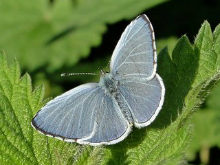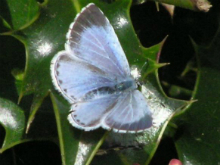
| Butterfly Conservation |
 |
| Hertfordshire & Middlesex Branch |
 |
|
|||
| Saving butterflies, moths and our environment | ||||


Holly BlueCelastrina argiolusWidespread and common Distribution and Status The Holly Blue is widespread and common in our branch area, more so in urban Middlesex. It is absent in some areas in arable north Hertfordshire. Numbers fluctuate widely giving rise to a regular cycle of between four and seven years, believed to be caused by a parasitic ichneumon wasp Listrodiomus nyethemerus although climate is also probably a factor Habitat Requirements Parks and gardens as well as churchyards, woodland rides and hedgerows. This is the only British butterfly to select different foodplants depending upon the season Larval Foodplants Holly Ilex aquifolium in the spring and Ivy Hedera helix in late summer. Alternative plants occasionally used include Gorse Ulex europaeus, Dogwood Cornus sanguinea, Bramble Rubus fruticosus and Raspberry R. idaeus Adult Food Sources Buddleia Buddleja davidii, Bramble R. fruticosus agg., Forget-me-not Myosotis sp., Veronica Hebe x francisana Behaviour/Observation notes Unlike the other 'blues', in some ways the Holly Blue behaves more like a 'hairstreak' as it frequents holly and ivy trees. Owing to its strong flight it can be frustrating to get a close-up view but if females are egg-laying then opportunities for taking a photograph are greater. It often basks with its wings half open in the early morning but later in the day they are usually closed. Males sometimes visit the ground on mud or puddles, and animal droppings Life History The Holly Blue produces two generations a year but a partial third brood is sometimes produced as in 1997, 2004 and 2018 when reports came in for October sightings. Eggs are laid singly on unopened flower buds of any number of foodplants in the spring, and ivy in late summer. Larvae feed on the buds leaving holes which is a clue to their presence on neighbouring buds. Larvae leave the foodplant when fully grown to pupate on the ground. Those which pupate from the late summer brood overwinter in this stage Further information
UK distribution map |
Copyright Butterfly Conservation © 2019 Hertfordshire & Middlesex Branch
Privacy and Copyright Statement and Cookie Policy Statement
Butterfly Conservation
Company limited by guarantee, registered in England (2206468)
Registered Office: Manor Yard, East Lulworth, Wareham, Dorset, BH20 5QP. Tel: 01929 400 209
Charity registered in England & Wales (254937) and in Scotland (SCO39268). VAT No. GB 991 2771 89